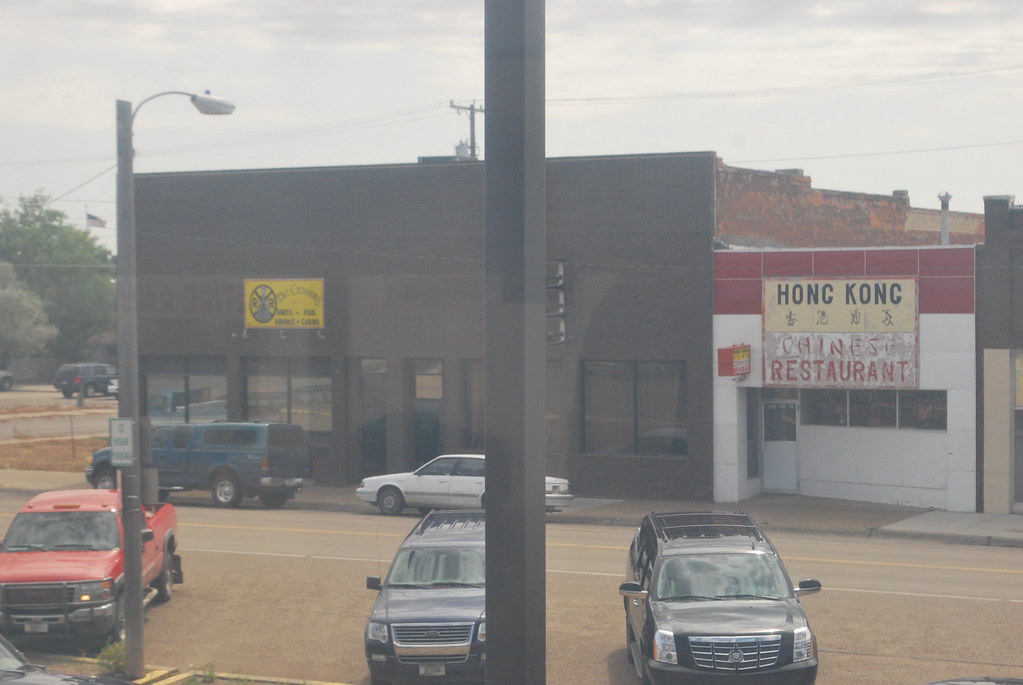I wonder if I’ve observed a genuine phenomenon or if I’m falling into a confirmation bias trap. Everywhere I travel, and I meander through extremely rural areas as a matter of preference, I notice Chinese restaurants.
This isn’t the first time I’ve mentioned this peculiarity. I posted Not Fusion, CONfusion a couple of years ago. The subject matter differed — I focused on oddly bifurcated business in that instance — although Meh’s Canadian & Chinese Cuisine in Tatamagouche, Nova Scotia would certainly qualify as an example of a Chinese restaurant in a rural area. I wrote at the time, “I’m continuously amazed to find Chinese restaurants in even the smallest, most remote and undoubtedly obscure towns that I’ve ever visited.” That odd fixation of mine hasn’t dissipated over time.
My Most Recent Experience
It came back to life when I was in Guymon, Oklahoma recently.
I noticed a Chinese buffet practically across the street from our hotel. Perhaps I shouldn’t have been too surprised by the Guymon occurrence. It’s the “big city” of the Oklahoma panhandle with nearly 12,000 residents. About 2.7% of the population (~300 people) self-identified as Asian in the most recent census albeit many of them Burmese not Chinese.
Guymon probably fit within the definition of confirmation bias now that I’ve had an opportunity to consider the math. To my credit though, we’d been driving through empty terrain for several hours and the juxtaposition flashed on my conscious brighter than a neon sign.
But Why?
It’s hard for me to conceive of the cultural isolation that these proprietors must endure in the most extreme examples. I came across one article [no longer available] that highlighted the story of a family of Chinese immigrants with US-born children that settled in Lexington, Nebraska. The ability to own one’s own business and earn a decent living in small town America provided an enticing option to urban problems. So maybe the American Dream makes up for the difference. They seemed to be assimilating just fine.
There are several dimensions one could use to determine the most remote Chinese restaurant in North America. I’m not sure I’ll ever answer the question to my complete satisfaction although I offer a few tantalizing possibilities.
Obviously I’ve never been to any of these places and I have no idea if the limited online reviews I could find are even remotely true. I’m also sure theses places represent the most bastardized version of westernized Chinese cuisine imaginable to match the tastes of their clientele, and I’m a sucker for that. I enjoy authentic cuisine too. I try to appreciate the dichotomy for what it is, and recognize that they should never be compared.
Hong Kong Chinese Restaurant, Glasgow, Montana

Glasgow has about 3,200 residents with 0.3% of the population (about 10 people) self-identified as Asian. That’s not to say that every one of those residents identify as Chinese of course, a distinction I’ll note similarly for the remainder of the article, although it does provide an indication of the potential population pool.
Google Street View (image) led me to wonder if the Hong Kong Chinese Restaurant was still open. Reviews in Yelp dated as recently as 2011. However, Street View dated to 2008. Maybe it simply needed a good coat of paint.
One person said, “This is the most awful restaurant I’ve been to.” Another said, it was “One of the best meal[s] I had in Montana.” Turning to Urban Spoon, a reviewer noted, “Average is ok in this case — I didn’t get sick after eating here either. This is my first criteria when writing a review for any Eastern Montana restaurant.” I learned a couple of things. First, Chinese food in Glasgow, MT is either excellent, terrible or average. Second, the standard of excellence might not be very high in Eastern Montana. I wonder if Weekend Roady would agree?
Golden China Restaurant, Nome, Alaska
Nome has 3,700 residents with 1.54% of the population (about 55 people) self-identified as Asian. That’s both a larger town and a higher percentage than the previous example. I’m including it on my short list anyway because anything in Nome has to be considered remote by definition.
Golden China Restaurant has some photos on Yelp and a small number reviews on Google+ [no longer available]. One said, “The waitress never smiles, she looks mean.” There was also a review in Korean which Google translated with the usual mangled results: “Korean pineapple chicken boss recommended. Tang manipulative called look. My Mongolian beef was too salty and sweet taste. Atmosphere clean and good music.“
In Nome, be sure to look for the surly waitress and stick with the Korean pineapple chicken boss.
Viking Chinese Restaurant, Viking, Alberta
Viking has about 1,000 residents. However it’s in Canada and I don’t know enough about the Canadian census to determine demographics. I highlighted this location primarily because I loved the possibility of Viking-Chinese fusion cuisine. It’s too bad Viking is the town’s name and not an indicator of culinary style.
I couldn’t find any online reviews. However, strangely enough, two people checked in with foursquare from Viking Chinese. You can do the same if you need to kill some time in Edmonton and want to take a 137 kilometre road trip.
Ying Bin Restaurant, Kenmare, ND
Is Ying Bin Restaurant the champion of remoteness? Kenmare has 1,000 residents with 0.7% of the population (about 7 people) self-identified as Asian. That’s a tad better (meaning fewer) than Glasgow, MT. Conceivably, just about every person in Kenmare of Chinese heritage could be associated with the Ying Bin Restaurant. I found only one brief review [no longer available]: “Food is superb, when made fresh.“
Those are my candidates for the most remote Chinese restaurants in North America. Can the 12MC audience do better? — double bonus points if you’ve actually eaten there. Triple points if you’re the restaurateur.

Leave a Reply